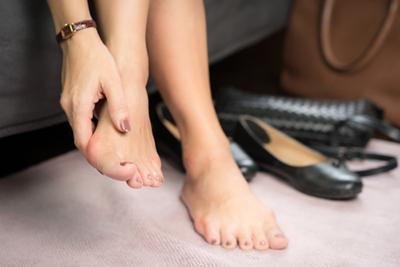Treating Your Bunion Symptoms

- posted: Sep. 13, 2023
Bunions are a common problem. In fact, over half of the women in the United States have developed a bunion at some point, according to the American Academy of Orthopedic Surgeons. Your podiatrist can help.
What You Need To Know About Bunions and Bunion Treatment
You are more likely to develop a bunion if you have a genetic bone formation that causes your big toe joint to protrude outward. The big toe joint rubs against the inside of your shoe, causing irritation. The irritation is followed by inflammation, and then bunion formation. The bunion will appear as a hard, bony bump on the side of your big toe.
If you are suffering from a bunion, you already know how it can impact your life, affecting your mobility and making it difficult to wear shoes. For a small bunion, you may be able to treat it at home. You can try:
- Placing an ice pack on the bunion several times during the day
- Using padding or inserts inside your shoes
- Taping your foot and toe to support the bunion
- Switching to wider, more supportive shoes with plenty of room for your toes
- Taking over-the-counter pain and anti-inflammatory medication
For larger, more painful bunions, you should seek out the help and expertise of your podiatrist. Treatment begins with a comprehensive examination of your foot, toe, and the bunion. Your podiatrist may recommend imaging studies to determine the level of bone involvement in the bunion. After a thorough evaluation, your podiatrist may recommend these common professional treatments for bunions:
- Custom-fit padding to reduce friction
- Custom-fit footwear to reduce irritation
- Custom-fit orthotics to stabilize your toe
- Removing corns or calluses on your feet
- Exercise and physical therapy to increase mobility
- Night splints to help realign your toe and foot
In severe cases, your podiatrist may recommend surgery to remove the bunion, a procedure known as a bunionectomy. Your podiatrist can discuss this option with you. Remember that you can do a lot to prevent bunions. Wearing shoes with plenty of room for your toes can help.
Want To Know More?
To find out more about the causes, signs, symptoms, and treatment of bunions, talk with an expert. Call your podiatrist today.

- posted: Sep. 13, 2023
Bunions are a common problem. In fact, over half of the women in the United States have developed a bunion at some point, according to the American Academy of Orthopedic Surgeons. Your podiatrist can help.
What You Need To Know About Bunions and Bunion Treatment
You are more likely to develop a bunion if you have a genetic bone formation that causes your big toe joint to protrude outward. The big toe joint rubs against the inside of your shoe, causing irritation. The irritation is followed by inflammation, and then bunion formation. The bunion will appear as a hard, bony bump on the side of your big toe.
If you are suffering from a bunion, you already know how it can impact your life, affecting your mobility and making it difficult to wear shoes. For a small bunion, you may be able to treat it at home. You can try:
- Placing an ice pack on the bunion several times during the day
- Using padding or inserts inside your shoes
- Taping your foot and toe to support the bunion
- Switching to wider, more supportive shoes with plenty of room for your toes
- Taking over-the-counter pain and anti-inflammatory medication
For larger, more painful bunions, you should seek out the help and expertise of your podiatrist. Treatment begins with a comprehensive examination of your foot, toe, and the bunion. Your podiatrist may recommend imaging studies to determine the level of bone involvement in the bunion. After a thorough evaluation, your podiatrist may recommend these common professional treatments for bunions:
- Custom-fit padding to reduce friction
- Custom-fit footwear to reduce irritation
- Custom-fit orthotics to stabilize your toe
- Removing corns or calluses on your feet
- Exercise and physical therapy to increase mobility
- Night splints to help realign your toe and foot
In severe cases, your podiatrist may recommend surgery to remove the bunion, a procedure known as a bunionectomy. Your podiatrist can discuss this option with you. Remember that you can do a lot to prevent bunions. Wearing shoes with plenty of room for your toes can help.
Want To Know More?
To find out more about the causes, signs, symptoms, and treatment of bunions, talk with an expert. Call your podiatrist today.
